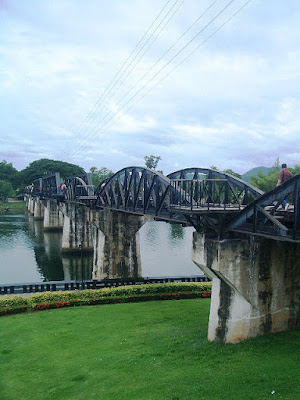 I went on a day trip to Kanchanaburi last Friday to see the Thailand-Burma Death Railway (or at least a section of it). The site was made popular by the book and film, The Bridve Over the River Kwai (1957); I've only seen some parts of the Oscar-winning movie.
I went on a day trip to Kanchanaburi last Friday to see the Thailand-Burma Death Railway (or at least a section of it). The site was made popular by the book and film, The Bridve Over the River Kwai (1957); I've only seen some parts of the Oscar-winning movie.Kanchanaburi province has long been a popular tourist attraction because aside from the historical site, there are also a number of waterfalls around the area. I heard there are also elephant treks in the jungle. But then, we're not there for those elephants, although I would've loved to be on one (always have).


We had three guests from Malaysia who wanted to see historic location and my boss thought it would be a good idea for me to go with them as well. I'm not really a big fan of war memorials. They make me sad all the time.
The section of the railway that was featured in film is actually called as The Bridge Over the River Kwai. It is still used as a part of the Thai railway system. A commuter train did pass by, intruding the camwhoring of the hordes of tourists that day.
The section of the railway that was featured in film is actually called as The Bridge Over the River Kwai. It is still used as a part of the Thai railway system. A commuter train did pass by, intruding the camwhoring of the hordes of tourists that day.
 Honestly, at the onset I did not have any feelings for the bridge at all. After having lunch in the floating restaurant, however, we drove to the brilliant Thai-Burmese Railway Museum. It was there that I learned more of the atrocities during the construction of the railway.
Honestly, at the onset I did not have any feelings for the bridge at all. After having lunch in the floating restaurant, however, we drove to the brilliant Thai-Burmese Railway Museum. It was there that I learned more of the atrocities during the construction of the railway.POWs were carted all the way from Malaysia and Singapore to work under appalling conditions set by the Japanese. Thousands of these men eventually died. Roughly eighty percent of the death toll were Malay and Indian Malaysians, and around ten percent were Burmese. The British, Australian, Dutch, and American POWs who died accounted for only less than twelve percent.

Across the museum is a cemetery for those POWs. I was quite struck by the age range of the men who died. Most of them were in their early to late 20s (my colleague saw a grave of an 18 year old soldier). It was heartwrenching thinking of the future that was robbed from them.
So I finally had the chance to see Kanchanaburi, but it did not leave me any pleasant experience coz I actually felt depressed after visiting those reminders of man's cruelty to each other.
To lighten up the mood of this entry, I'm posting a picture of Saphan Taksin, which I took on the way to the house-warming party of a Pinay friend. The second photo is a view from her apartment, which is from the Thonburi side of the Chao Phraya.
So I finally had the chance to see Kanchanaburi, but it did not leave me any pleasant experience coz I actually felt depressed after visiting those reminders of man's cruelty to each other.
To lighten up the mood of this entry, I'm posting a picture of Saphan Taksin, which I took on the way to the house-warming party of a Pinay friend. The second photo is a view from her apartment, which is from the Thonburi side of the Chao Phraya.



No comments:
Post a Comment